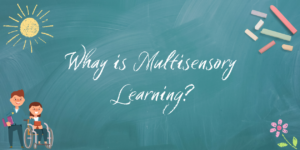 What is Multisensory Learning?
What is Multisensory Learning?
Multisensory learning is all about encouraging learners to use more than one of their senses when taking in new information. This learning style promotes using activities that appeal to our visual, auditory, kinaesthetic and tactile senses. It might also include gustatory, olfactory, proprioceptive or vestibular senses.
It’s so much more powerful to experience something than just hear about it.
There’s a difference between getting information and truly understanding it. For example, you can tell a young child what an apple is, but it’s not the same as her crunching into one. The experiences of seeing the vibrant colour, feeling its texture, smelling its fragrance — these are the real elements of an apple.
The ‘apple experience’ we just described was powerful because it engaged all the child’s senses. And each of these senses is a different pathway to her brain. So, the more of them she engages, more her brain can learn. This means that even if your child prefers to learn by watching, she’ll learn better if that watching is supplemented by hearing, touching, and doing. And for the best multisensory experience — like with the apple — she’ll engage all her senses at once. (It’s something called simultaneous multisensory instruction.
Below are some ideas To encourage a multisensory approach:
I. To stimulate visual reasoning and learning
- Text and/or pictures on paper, posters, models, projection screens, computers or flash cards
- Use of colourfor highlighting, organizing information or imagery
- Graphic organizers, outlining passages
- Student created art, images, text, pictures and video
- The above mentioned techniques often include visual teaching methods and strategies.
II. Auditory techniques
- Books on tape, peer assisted reading, paired reading and computerized text readers
- Video or film with accompanying audio
- Music, song, instruments, speaking, rhymes, chants and language games
III. Tactile teaching methods
Multi sensory techniques that involve using the sense of touch are called tactile methods. Tactile methods include strategies such as:
- Sand trays, raised line paper, textured objects, finger paints and puzzles to improve fine motor skills
- Modelling materials such as clay and sculpting materials
- Using small materials called manipulatives to represent number values to teach math skills
IV. Kinaesthetic methods
Multi sensory methods using body movements are called kinaesthetic methods. These involve fine and gross motor movements.
- Games involving jumping rope, clapping or other movements paired with activities while counting and singing songs related to concepts.
- Any large movement activity involving dancing, bean bag tossing or other activities involving concepts, rhythmic recall and academic competition such as quizzes, flash card races and other learning games

